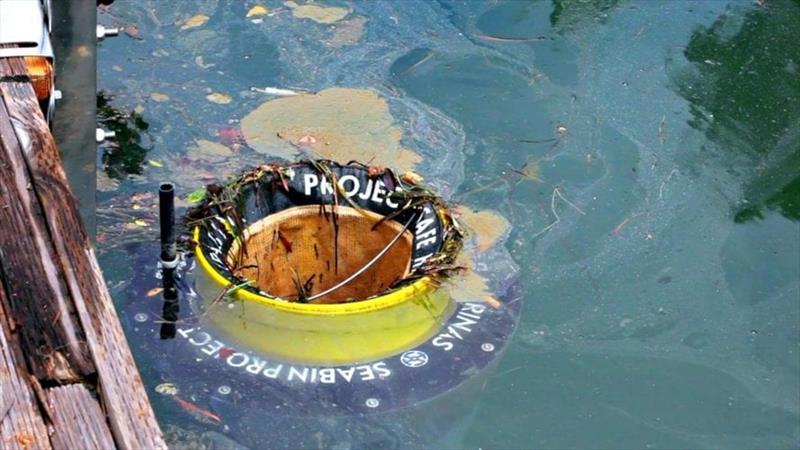
SF's Pier 39 Marina joins Emeryville & Alameda Marinas' fight against pollution with Ocean Vacuums
by Mary Lou 15 Jul 2019 14:57 UTC

Seabin Project © Mary Lou
Seabin Project, the Aussie innovation that's tackling marine plastic pollution and educating the next generation of ocean savers, installed a new Seabin in the Pier 39 Marina Thursday, July 11th. This is the area where families gather to watch the sea lions. Why is this so important?
The Seabin is a device created to reduce, and ultimately eliminate pollution in our oceans. Seabins act as a trash can for our waters and have the ability to remove microplastics, microfibers, plastic bags, bottles, cigarette butts and more. You should see what people throw into our waterways. Many people are not familiar with the direct link between climate change and marine plastic pollution. But, out of the 320 million metric tons of new plastic mass-produced each year - almost all from oil - 8 million tons leak into the world's oceans and waterways. Youv'e seen the Great Pacific Garbage Patch? At last sampling there were 1.8 trillion pieces of plastic in the patch that weigh an estimated 80,000 tons. Since Seabin Project was co-founded by Andrew Turton and Pete Ceglinski, two avid ocean lovers, there have been Seabins installed in over 40 countries. What does this mean? Each day, a total of 1.95 tons of waste is extracted from our oceans. (Learn more about their innovative technology here.)
But Seabin Project doesn't just stop with cleaning up our oceans. Their mission is to live in a world where the Seabin technology is not necessary, so they have dedicated their time to educate communities across the world about how to fight the plastic pandemic through concepts of reactive + preventative solutions and implementing Ocean Plastic STEM learning programs. (Learn more about Seabin's education programs here.)
Seabins were installed in the Emeryville Marina and Alameda's Ballena Isle Marina in December of 2017, as their marina management company, Safe Harbor, participated in the Seabin Project's global pilot study, and continues to install Seabins in all the marinas they manage. Pier 39 Marina's Seabin is expected to remove 3 tons of marine pollution from San Francisco waters by end of 2019
Some Numbers:
- Total number of Seabins installed worldwide: 719
- Number of plastic bags that one Seabin can collect each year: 90,000
- Number of plastic bottles that one Seabin can collect each year: 11,900
- Total amount of marine litter captured to date: 114,916 kg (over the last 2.5 years)
- Total amount of marine litter captured each day: 1,952.33 kg
Here's how it all started. Two life-long surfer friends from Australia, appalled by the plastic and debris pollution in our waters, set out to clean up the ocean. They wanted to create a garbage bin that would collect the floating plastic. This got them started cleaning up the marine environment, one marina at a time. How? With the V5 Seabin, a floating vacuum filter device they invented that works like an ocean vacuum 24/7 continuously collecting floating debris - plastic bottles, paper, oil, fuel, detergent and more. Over two years Seabin Project co-founders Pete Ceglinski and Andrew Turton secured partners for a pilot study into the effectiveness of the seabin and now the Seabin Project has evolved into a comprehensive research, educational and technology initiative with worldwide reach, including educational tools for students to get on board. The Seabin Project team believes that each child that learns to dispose of litter properly will grow to be one less source person for pollution of our oceans and waterways. Currently, according to Jambeck Research, 8.1M tons of mismanaged waste enters our oceans every year.
Here's how it works:
- The seabin is installed in a specific problem debris area, attached to a dock.
- Water is filtered from the surface and passed through a catch bag inside the Seabin, powered by a submersible water pump.
- Water is then pumped back into the water leaving the litter and debris trapped in the catch bag. Larger pieces of plastic may attach themselves to the bin.
- Marina operators need to empty the catch bag at least twice a day, as it holds up to two pounds.
What are you doing to reduce your own plastic consumption? Make a climate action promise today!